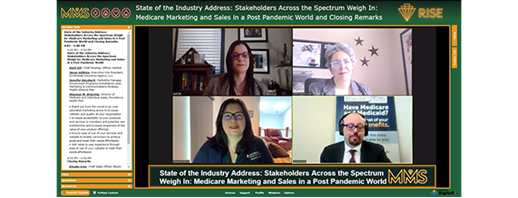Stakeholders across the spectrum convened for a state of the industry address during RISE’s virtual Medicare Marketing & Sales Summit this week to discuss their strategies to stand-out from the crowd, increase members’ accessibility to products and services, and ensure a friendly user experience. Here are the key takeaways from their conversation.
Get creative to stand out in an oversaturated market
During the panel discussion, which was moderated by April Gill, chief strategy officer, Welltok, speakers shared their favorite techniques to increase visibility and quality of their organizations to stand out from their competition. In an oversaturated market like Los Angeles, it requires consistent creativity, explained Jason Vallejos, executive vice president, Syndicated Insurance Agency, LLC, who turned to social media to create videos on YouTube and Facebook to reach members in a virtual world. “This year moved from taking clients out to fine dining and wining to live studio recording,” he said. “If agents weren’t accustomed to the camera, they’ve had to learn to be.”
While the inability to host in-person meetings and events was challenging, it did open up money in the budget to explore other marketing avenues, noted Shannon M. Drotning, director of Medicare and individual sales, Providence Health Plan. Using the cost savings that would have otherwise been spent, Providence Health Plan focused on niche marketing in community papers, magazines, and church bulletins, all of which are outlets that the plan would typically overlook but really do work to reach members, said Drotning.
Jennifer Rossbach, marketing manager, government programs/compliance lead, marketing & communications strategy, Health Alliance Plan, took a similar approach and used print advertising, which she said has performed spectacularly due to COVID, with calls increasing from one or two per day to between 100 and 200 calls in a day. A key to the print advertising success, noted Rossbach, was the use of localized phone numbers in the marketing rather than the typical 800 numbers they have used in the past.

Reconsider former marketing tools
The creativity to stay in front of members didn’t stop with new integrative ideas. In fact, some throwback marketing tools proved to be useful amid the pandemic. For Syndicated Insurance Agency, LLC, it was the use of QR codes. “The QR code was about to die off,” said Vallejos, noting the lack of use of the codes prior to COVID-19. “Now to look at any menu at a restaurant, you use a QR code.” While the agency continues to print advertising, they incorporate QR codes for a hybrid model, he explained, noting the tool has been especially useful for their younger Medicare eligible population with disabilities as the average Medicare-eligible in California is 45 years old.
Drotning and Rossbach found success by investing more time into their broker relationships. “We’ve noticed in a COVID environment that just doing licensed training isn’t enough anymore,” said Rossbach. “We need to really be in front of those brokers helping them understand the value propositions.” After each Annual Election Period, the health plan also recognizes and rewards the top 10 agents, brokers, and FMOs.
Providence Health Plan was able to branch out to surrounding counties throughout the pandemic based on the brokers’ referrals for others in the communities who may be interested, said Drotning.
Identify best practices to carry into the future
While health plans and members eagerly await the return to face-to-face interactions, the COVID-19 pandemic has brought innovative ideas to light that may be worth keeping around. Vallejos and Rossbach both intend to maintain a newfound best practice in regular team huddles to maintain cross-functional communication. “When the company is singing from the same song sheet, it’s miraculous,” said Rossbach.
The pandemic forced each health plan to fully leverage the digital world, whether that meant increasing its use of an existing channel or creating new ones altogether. Key methods they plan to maintain post-pandemic include digital enrollment tools, microsite chat accessibilities, Facebook live events, and online appointment scheduling. Interestingly, each panelist found Wednesdays to have the highest engagement in their digital outreach.
When the time does come for face-to-face meetings and events to resume, a hybrid model with a combined approach of pre- and post- pandemic practices will be crucial, according to the panelists.
